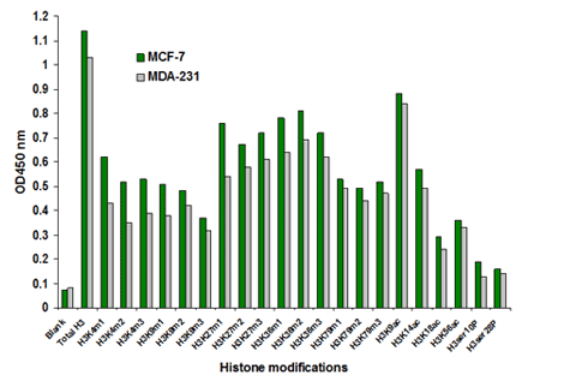EpiQuik Histone H3 Modification Multiplex Assay Kit (Colorimetric) - 96 assays
The EpiQuik™ Histone H3 Modification Multiplex Assay Kit (Colorimetric) is a complete set of optimized reagents to detect and quantify up to twenty-one (21) modified histone H3 patterns simultaneously in a simple, ELISA-like format with use of a standard microplate reader. The kit has the following advantages and features:
- Simultaneously screen and measure 21 different histone H3 modifications, which includes all of the most important and the most well-characterized patterns.
- Quick and efficient procedure, which can be finished within 2 hours and 30 minutes.
- Innovative colorimetric assay without the need for radioactivity, electrophoresis, chromatography, or expensive equipment.
- High sensitivity with a detection threshold as low as 0.5 ng/well for each modification pattern and a detection range from 20 ng to 500 ng/well of histone extracts.
- An assay control is conveniently included for quantification of each histone H3 modification.
- Total histone H3 sets are included, which can be used for normalizing total histone H3 levels for relative comparison of histone H3 content between different samples or different treatment conditions.
- Strip microplate format makes the assay flexible: manual or high throughput, which enables analysis of a single modification or total 21 modification patterns within the same samples.
- Two extra 8-well strips are included in the kit which can be used, if necessary, for sample amount pre-optimization to determine the input amount (ex: 50, 100, 200 ng/well) needed to fall within the detection limits of the assay. Extra strips may also be used as assay controls and total histone level controls if selective detection of some histone H3 modifications from the total 21 modification pattern is desired.
- Simple, reliable, and consistent assay conditions.
have been defined as epigenetic modifiers. Post-translational modifications (PTMs) of histones include the acetylation of specific lysine residues by histone acetyltransferases (HATs), deacetylation by histone deacetylase (HDACs), the methylation of lysine and arginine residues by histone methytransferases (HMTs), the demethylation of lysine residues by histone demethylases (HDMTs), and the phosphorylation of specific serine groups by histone kinases (HKs). Additional histone modifications include the attachment of ubiquitin (Ub), small ubiquitin-like modifiers (SUMOs), and poly ADP-ribose (PAR) units. Next to DNA methylation, histone acetylation and histone methylation are the most well characterized epigenetic marks. Generally, tri-methylation at H3-K4, H3-K36, or H3-K79 results in an open chromatin configuration and is therefore characteristic of euchromatin. Euchromatin is also characterized by a high level of histone acetylation, which is mediated by histone acetyltransferases. Lysine residues can be mono-, di-, or tri-methylated, each of which can differentially regulate chromatin structure and transcription. Along with other histone modifications such as phosphorylation, this enormous variation leads to a multiplicity of possible combinations of different modifications. This may constitute a “histone code”, which can be read and interpreted by different cellular factors.
Principle & Procedure
In an assay with this kit, each histone H3 modified at specific sites will be captured by an antibody that is coated on the strip wells and specifically targets the appropriate histone modification pattern. The captured histone modified at specific sites will be detected with a detection antibody, followed by a color development reagent. The ratio of modified histone is proportional to the intensity of absorbance measured by a microplate reader at a wavelength of 450 nm.
Starting Materials
Input materials can be histone extracts or purified histone H3 proteins. The amount of histone extracts for each assay can be 20 ng to 500 ng with an optimal range of 50 ng to 100 ng depending on the purity of histone extracts. The amount of purified histone H3 proteins for each assay can be 1 ng to 25 ng with an optimal range of 4 ng to 5 ng.

 Fig. 3. Histone extracts were prepared from MCF-7 and MDA-231 cells using the EpiQuik™ Total Histone Extraction Kit (Cat. No. OP-0006) and multiple histone H3 modifications were screened and measured using the EpiQuik™ Histone H3 Modification Multiplex Assay Kit (Colorimetric). 100 ng of total histone proteins were used.
Fig. 3. Histone extracts were prepared from MCF-7 and MDA-231 cells using the EpiQuik™ Total Histone Extraction Kit (Cat. No. OP-0006) and multiple histone H3 modifications were screened and measured using the EpiQuik™ Histone H3 Modification Multiplex Assay Kit (Colorimetric). 100 ng of total histone proteins were used.
Related Products
Researchers Also Purchased
%20-%2096%20assays?unique=325b45d)